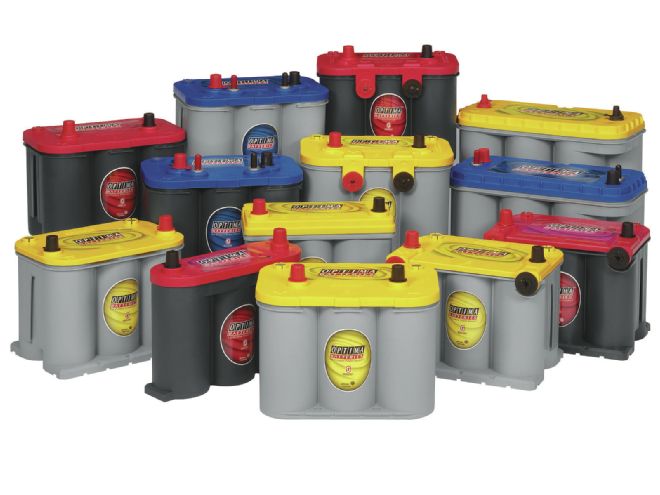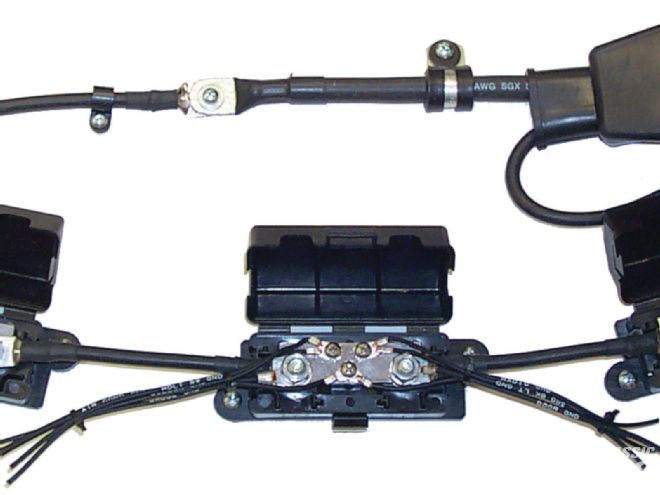
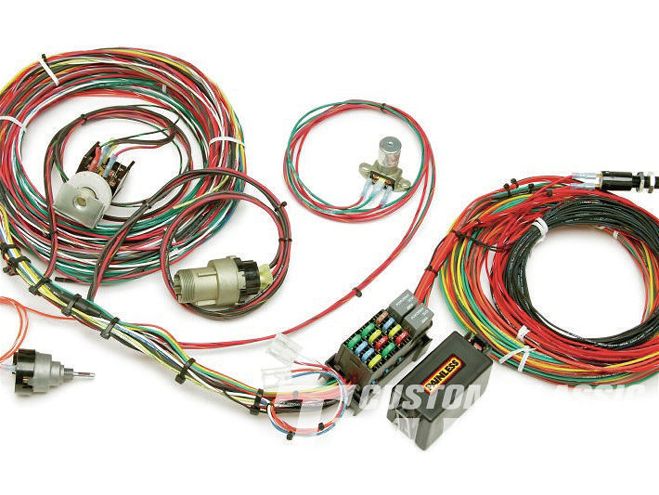 1. For 1967-1977 Ford F-Series trucks Painless offers this 14-circuit harness. It uses original Ford OEM color codes and includes pre-terminated sections including headlight switch, headlights, turn switch, ignition switch, wiper switch, instrument cluster, blower motor, and voltage regulator. New headlight, ignition, dimmer, wiper, and brake switches are included.
1. For 1967-1977 Ford F-Series trucks Painless offers this 14-circuit harness. It uses original Ford OEM color codes and includes pre-terminated sections including headlight switch, headlights, turn switch, ignition switch, wiper switch, instrument cluster, blower motor, and voltage regulator. New headlight, ignition, dimmer, wiper, and brake switches are included.
For many custom classic truckers there is an element of mystery, even black magic, when it comes to electrical systems. For the most part, the mechanical aspects of our vehicles are easy enough to deal with—at least they can be seen, held, and even heard. The same can’t always be said for electricity; you can’t point to it and say, “There it is.” But then anyone who has made contact with the business end of a running engine’s spark plug wire will testify to its existence.
Selecting A Wiring Kit
One of the tasks normally required to make an old truck fully functional is refurbishing the electrical system. In most cases, time has taken its toll on the wires, switches, and the rest of the components, rendering them borderline at best and flat out hazardous at worst. Of course, even if an older truck’s original wiring is in usable condition, don’t count on the system supporting the variety of electrical components that are commonly added today. Something as simple as plugging in halogen headlights can overload an OEM system, and adding A/C and a stereo is more than likely out of the question without some updates.
At one time, rewiring a truck meant a trip to the parts house for a bunch of connectors and spools of wire (usually all the same color). The end result was often a failure-prone system that was impossible to trace. The other option often seen was cutting up a harness from a later-model car or truck; this rarely worked well because there were either too many circuits or not enough; wires were either too long or too short—the final result was seldom worth the effort.
Without a doubt, the quickest, most effective, and affordable method of updating a truck’s wiring system is to start from scratch and install one of the complete wiring kits that are available. Plug-and-play systems are made for every conceivable application and range from those that provide for basic electrical needs to those that can power up every known electrical accessory.
When shopping for a wiring harness, there are a number of things to consider. First off, there are two basic types of wiring kits being offered—one has the wires running from the loads and they are then connected to the fuse panel. The other comes with all the wires attached to the fuse block and they are run to the loads where they are connected. Both methods have merit; the choice often comes down to ease of installation.
Number of Circuits: Another consideration is the number of electrical circuits needed. In some cases, few circuits are required. However, if a long list of electrically operated comfort items will be included, more circuits are necessary. It never hurts to plan ahead; if your truck doesn’t have air conditioning, but you plan on installing it later, chose a harness that provides that option.
Labels and Color Codes: A quality wiring kit will have color-coded wires that are also labeled with its function. This not only simplifies installation, but also makes troubleshooting easier if the need arises.
Number of Connections: Typically electrical system issues are the result of bad connections. The more connections that are made by the harness manufacturer, the fewer there are to cause problems later.
Location of the Fuse Panel: Generally the fuse panel will be located under the dash at or near the original’s location. However, in some instances it’s more desirable to locate it somewhere else, under the dash on the passenger side, behind the seat, or in the glovebox. For such installations check for kits with longer than standard wires.
Grounds: Many electrical problems are caused by something as simple as a poor ground. Ground wires must be connected to a clean, bare metal surface. Paint and powdercoated surfaces are great insulators, which makes them lousy grounds. There is no such thing as over-grounding—the battery should be grounded to the chassis, engine, and body.
Choosing An Alternator by Powermaster
Alternators are usually described by their output—65-amp, 100-amp, or whatever. When replacing the alternator on the family car, this is probably the only information that is necessary; all that’s needed is an alternator that matches the original. But when building a street rod from the ground up, a deeper understanding of the power curve of an alternator is required.
When selecting an alternator, the first thing you must know is how many amps the electrical system consumes. This, of course, varies from car to car and can be figured two different ways. One way is to add the total amp requirements of all components together. Generally all electrical items will have their supply demands included with the instructions.
Another way is to use an inductive ammeter with a “peak hold” function clamped around the battery cable while the car is running. While the latter method would be more accurate since it would be testing the electrical system as a whole in real-world conditions, it’s not always the most practical. The point is that when everything is turned on at the same time, the amperage demands on the electrical system can be surprisingly high, so select an alternator accordingly.
How Big is Big Enough?
An alternator’s output is dependent on speed, but this can be deceiving because this output is not linear. Instead, it follows a curve, and at idle, small changes in the alternator’s speed can make a big difference in its output capacity. An 80-amp alternator is capable of producing 80-amp maximum. It does not produce amps all the time, but rather only when it is needed and only in the amount needed. Therefore if a system uses 52 amps continuously, a 60-amp alternator could be used. However, an 80-amp alternator would work better. Why? Because the 80-amp alternator is working at 65 percent of its capacity whereas the 60-amp is working at 87 percent of its capacity.
This percentage, or duty cycle, affects the voltage that the alternator is able to maintain. The 60-amp unit will typically produce the 52 amps at a lower voltage than the 80-amp unit in the same situation. Therefore it is good to get the alternator with the highest amp rating available for a particular mounting situation.
Choosing A Battery
There’s nothing worse than hopping into your truck, hitting the starter, and hearing a click rather than a roar. For our money, the bet is to install the largest-capacity battery that will fit the vehicle. You never hear anyone complain, “My truck’s battery is just too powerful!”
Batteries are rated a variety of ways:
Ampere hours indicate how long a battery will deliver electricity before it goes dead. This rating can be misleading as testing is not always done at the same rate of discharge, so read and compare specifications carefully.
Cranking amperes is the amount of current a battery can provide at 32 degrees F. Cold cranking amperes is the amount of current a battery can provide at 0 degrees F. Hot cranking amperes is the amount of current a battery can provide at 80 degrees F. Reserve capacity minutes is a battery’s ability to deliver 25 amps before it drops below 10 volts.
AGM Batteries
Looking a little like a six-pack encased in plastic, Optima AGM batteries are extremely popular. AGM stands for Absorbent Glass Mat and refers to the separators that hold electrolyte like a sponge. These maintenance-free batteries are completely sealed, preventing corrosion and acid spills, are more than 15 times more vibration resistant, and can be mounted in almost any position (upside down is not recommended).
Optima RedTop batteries are designed for starting applications that require high amperage for a very short time. The discharge cycle is shallow and the alternator takes over after the battery starts the car.
Optima YellowTop batteries are dual-purpose, deep-cycle designs for starting your vehicle and to support a load of electronic accessories, including car alarms, audio systems, and lighting. These batteries are also ideal in vehicles that don’t have an alternator or have electrical demands that temporarily exceed the alternator’s output. It ensures that those high electrical demands are satisfied until you’re able to recharge. CCT
A Few Things You Should Know About Electrical Systems
Maxi fuse: Maxi fuses provide overall circuit protection. Like most other fuses, they come in many amperage ratings.
Circuit breakers: Circuit breakers come in many different amperage capacities and are used in circuits that have high loads and voltage spikes. An electric fan circuit is a good example of a circuit that a circuit breaker should protect.
Wire stranding: Did you know that in theory that current flows around the strands of wire? This means that the more strands of wire in a wire, the more current that wire can carry. When doing wiring of a circuit, be sure the wire is high quality and has maximum strands.
Ignition switches: Most aftermarket ignition switches are limited to about 60 amps of current-carrying capacity. Always use caution when using a universal switch that it is not overloaded by powering the electric fan circuit or the air-conditioning circuit without a relay.
LED flashers: LED flashers are required in many vehicles because of the installation of LED tail and front turn signal assemblies. LEDs do not pull enough current to trip the bi-metallic strip in a conventional flasher like the 1187-styles bulbs. LED flashers have built in resistance to solve the problem.
Computers and welding: Never weld on the chassis or other parts of your ride without disconnecting the battery and also the computer if so equipped. Electrical surges from welding can cause internal circuitry failure in a computer and could cause gasses from the battery to explode.
Electric fans: On average, an electric fan will require 1 amp per inch of overall diameter to operate at normal speed. For instance a 12-inch fan will require 12 amps to operate, but also note that twice the amperage is required during initial start-up. Be sure the circuit protection can handle the start-up load as well as the fan relay.
Hot/no start problems: GM large starters are well known not to activate when they get hot from driving. This is due to the solenoid plunger expanding due to the heat and sticking in its housing. A relay between the solenoid activation terminal and the battery source, to flow more current, will almost always remedy the problem.
Q. How do you identify your GM Internally Regulated Alternator?
Delco Remy (System Integrated) SI alternators were used on GM vehicles between 1969-1988. They were primarily used on vehicles between 1975-1985. Two of the most commonly used models were the 10SI and 12SI alternators.
A. Two key identification points of the SI alternator are the external fan with V-belt pulley and the two charge indicator light terminals (male blades) that appear on the backside of the alternator.
Q. What is a fusible link?
A. A fusible link is similar to a fuse; it is a type of circuit protector. It is a length of wire, typically 6 inches long, and usually two gauge sizes smaller than the wire it is protecting. If excessive current runs through the circuit, the wire overheats and melts, breaking the circuit. When a circuit has been broken, no electricity can flow. The fusible link has a softer nonflammable insulation that bubbles to indicate when it has blown.
Q. What are the common types of automotive wire?
A. There are two main categories of automotive wire: PVC and cross-linked. The biggest difference between the two categories is temperature range.
The three main types of PVC automotive wire are: GPT—used for general circuit wiring and rated to 80 degrees C; TWP—lead-free, thin-wall automotive wire rated to 105 degrees C; HDT—heavy-wall automotive wiring rated to 80 degrees C.
Cross-linked insulation is created by extruding polyethylene through a tube, under heat and pressure, in order to “cross-link” or change the molecules of the insulation to another state. Cross-linked automotive wire can withstand much higher temperatures than PVC automotive wire.
The three most common types of cross-linked automotive wire are: GXL—(used by American Autowire) it has thin-wall insulation and works with most standard automotive connectors, rated to 125 degrees C; SXL—standard wall, rated to 125 degrees C; TXL—extra-thin wall, best for applications that require minimal size and weight, rated to 125 degrees C.
2. This Painless Performance 12-circuit kit can be used in just about any vehicle where basic wring is needed. This kit includes GM (column-mounted) ignition switch connectors and a GM (column-mounted) turn signal switch connector pre-terminated and ready to install. Also included are pre-wire plugs for headlights and the dimmer switch.
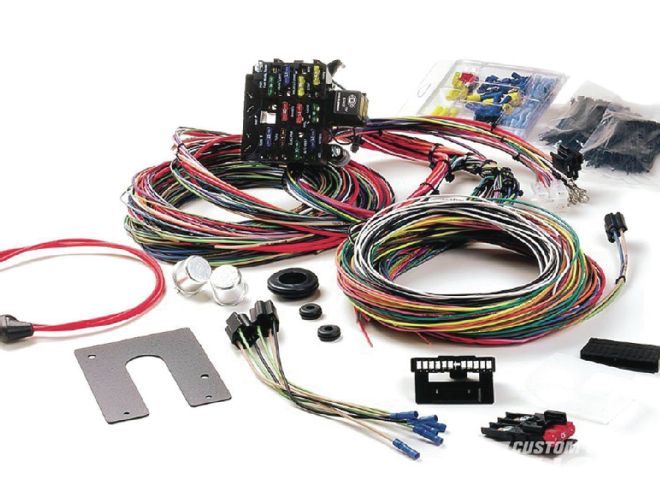
3. A wise addition to any truck is this full vehicle grounding kit from American Autowire. Bad grounds are often a source of electrical problems.

4. American Autowire’s complete wiring kit for ’60-66 Chevy pickups will accommodate GM SI, CS, or any one-wire alternator, stock or aftermarket instruments, heat and A/C, and stock or late-model steering columns.
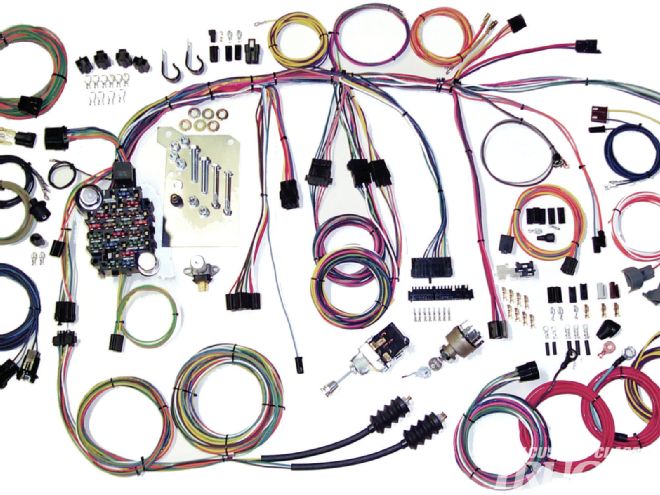
5. Any truck with basic electrical needs is a candidate for the American Autowire Highway 15 wiring harness. It has everything needed, including a headlight and dimmer switches.
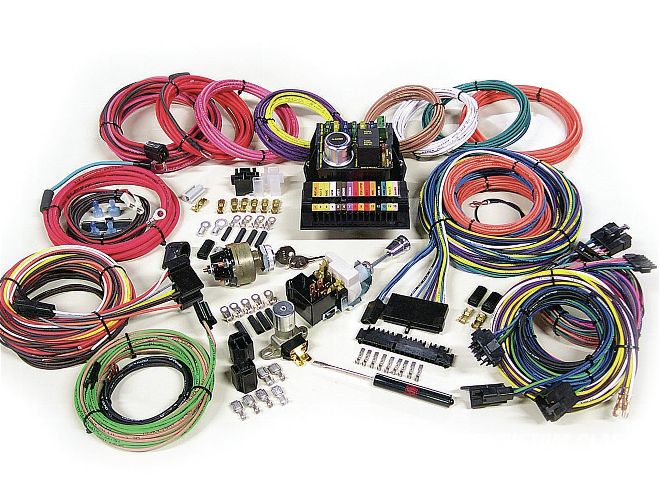
6. For custom installations with a variety of electrical accessories, the Highway 22 wiring kit from American Autowire is a modular system that provides 22 power circuits through 15 fuses and one circuit breaker.
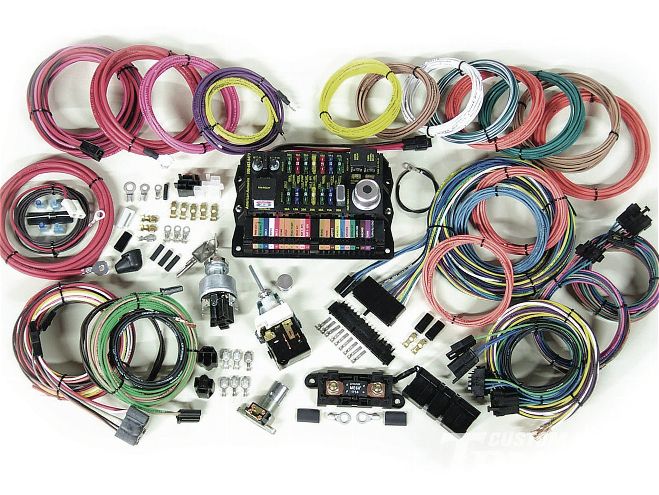
7. This Micro Fuse Harness from Painless offers an alternative to mounting the fuse block under the dash. The Micro Fuse block is 3x3½x2 inches yet holds 12 fuses and two relays. The fuse block is covered to keep it free from dirt and contaminants.
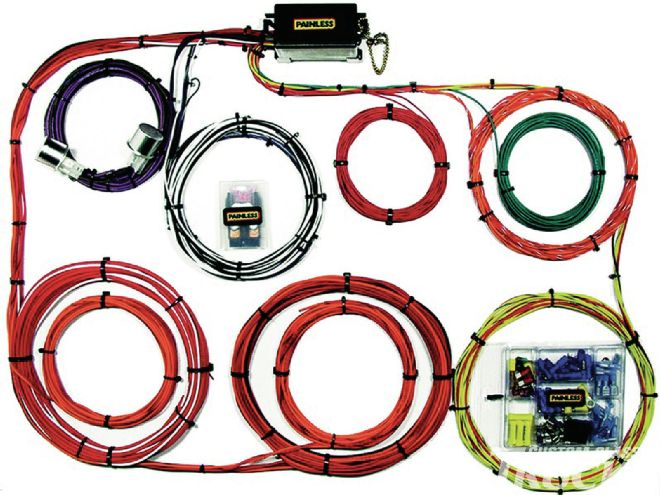
8. There are all sorts of cool electrical devices available, such as this low-voltage module from American Autowire. It can be used to trigger a warning light when the battery drops below 11 volts.
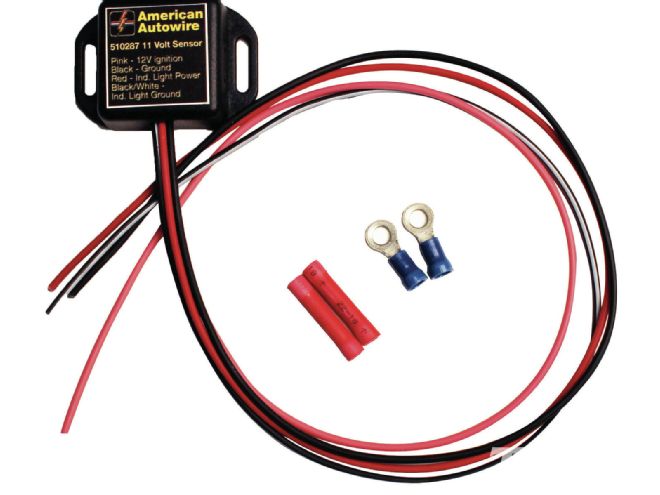
9. Painless offers the Fan-Thom II electric fan control. It comes with a threaded thermostat that screws into the engine block or intake. It provides constant voltage, protects the fan from voltage and amperage spikes, and prevents it from back feeding voltage through the vehicle’s wire harness.
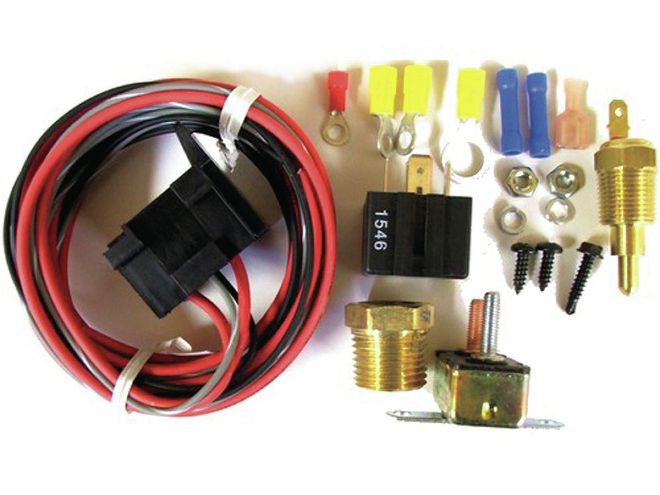
10. When installing a high-output alternator, the charging circuit must be able to handle the increased amperage. American Autowire offers high-amp alternator connection kit for that purpose.
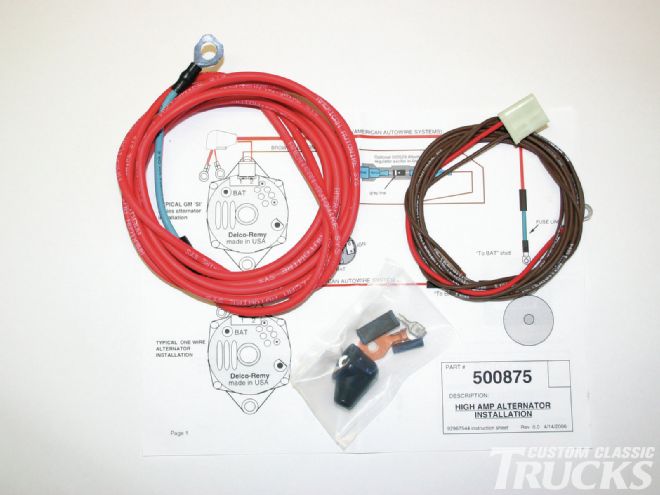
11. Powermaster offers a variety of alternators, some are available to look like vintage generators. This is their new Smooth Look 12SI alternator—its available with 100- or 140-amp output.
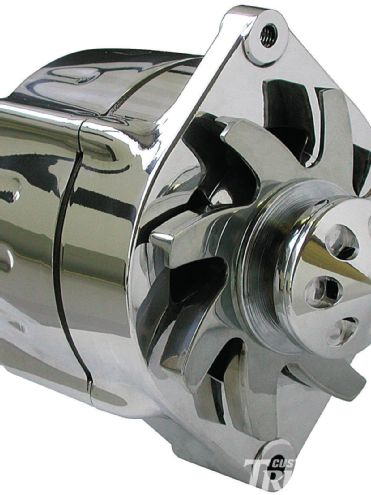
12. To protect and clean up any harness installation Painless offers this braided wire wrap. The laterally split design closes around wire bundle without the need for additional taping or zip ties.
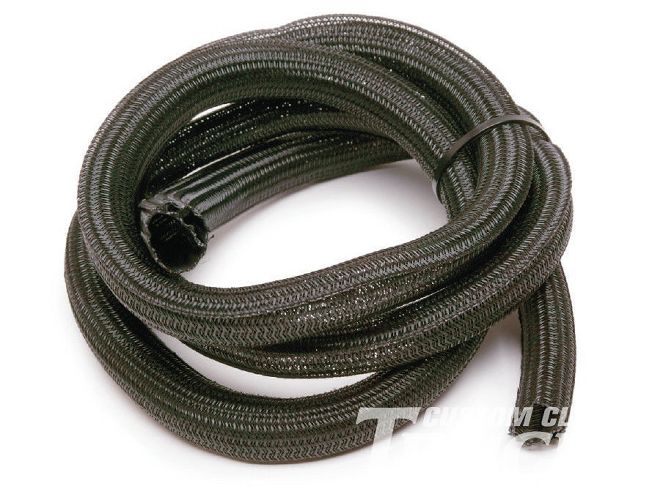
13. To make installations easier American Autowire offers several tools; this double crimp tool will secure double F-type terminals with 10- to 18-gauge wire.
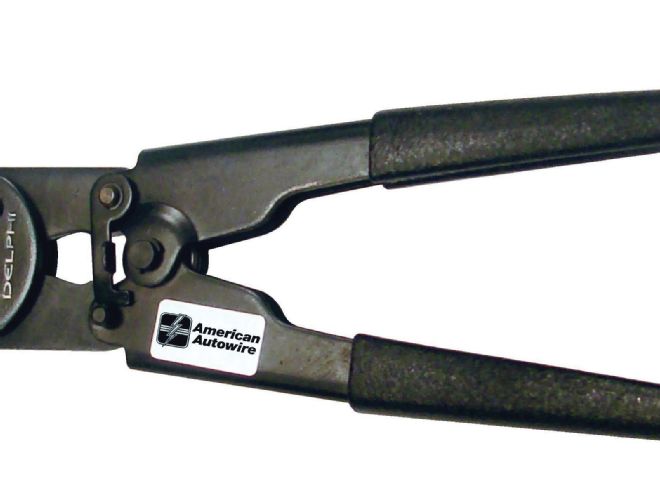
14. Also available is this crimper for 14- to 20-gauge wire. With both tools all the common connectors are covered.
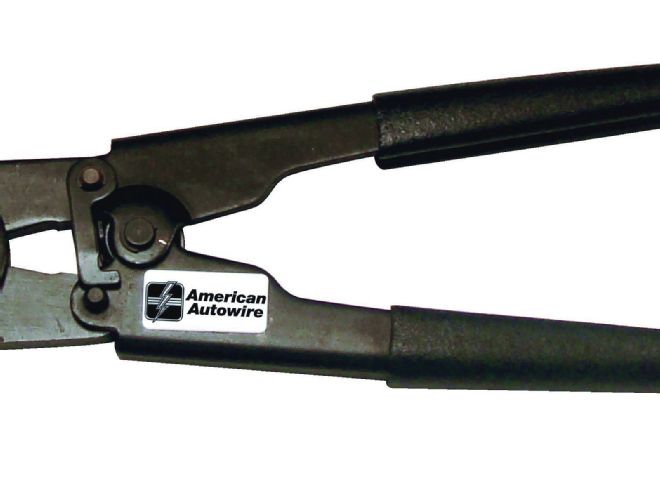
15. To protect wires that pass through holes, Painless can provide an assortment of rubber grommets.
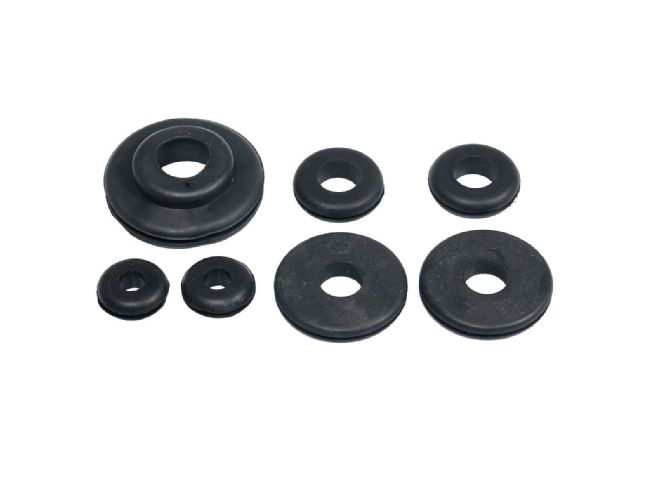
16. Optima 12-volt batteries come in RedTop (starting), YellowTop (deep cycle), and BlueTop (Marine). Starting batteries are also available in 6-volt.
